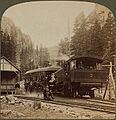Englemann Canyon facts for kids
Englemann Canyon (sometimes called Engleman's Canon) is a beautiful valley found along Ruxton Creek in Manitou Springs, El Paso County, Colorado. It's one of three main canyons in Manitou Springs, with the others being Ute Pass and Williams Canyon. This canyon is famous for being the starting point of the historic Pikes Peak cog railway!
Contents
Exploring Englemann Canyon's Upper Part
Back in 1880, a special trail was opened in Englemann Canyon that led all the way up to Pikes Peak. By 1883, this path was known as the Manitou Trail.
A man named Zalmon G. Simmons, who later invented the famous Simmons mattress, explored the canyon. He was looking for places to put telegraph lines, but he realized the canyon would be perfect for building a unique type of train track called a cog railway.
The Pikes Peak Cog Railway
The Manitou and Pike's Peak Railway was built by Zalmon Simmons and finished in 1890. This amazing railway starts right in Englemann Canyon. It follows Ruxton Creek as it climbs high into the Rocky Mountains towards Pikes Peak. The train goes up a very steep slope, about 6% grade, passing by tall spruce trees and rugged rocks.
The first part of the 8.9-mile (14.3 km) train ride goes through Englemann Canyon, right next to Ruxton Creek. Along the way, you can see huge boulders, Ponderosa pine trees, and different kinds of spruce trees like the Englemann spruce and Colorado blue spruce.
Famous Spots in the Canyon
As you travel through the canyon, you'll pass several interesting places:
- Artist Glen: This was once the home and bed and breakfast of an artist named William Hook and his family. Guests sometimes arrived by burro (donkey) on a trail near their home.
- Minnehaha Falls: A lovely spot named for its waterfalls, which was once a small group of cabins.
- Son-of-a-Gun Hill
- Hells Gate
- Halfway House: This was a rustic hotel where tourists could stop when riding the railway.
- Ruxton Park: A scenic area further up the canyon.
In 1891, a magazine called The Illustrated American described the canyon as a "narrow valley" with steep mountains on both sides. It mentioned the "clear, sparkling Ruxton Creek rushing parallel to the track," sometimes far below the train, and sometimes forming deep, calm pools where trout loved to swim.
In 1925, the city of Colorado Springs built a power plant in Ruxton Park. This stone hydroelectric plant uses the flow of Ruxton Creek to generate electricity as the water travels down from the mountain into Manitou Springs.
Lower Englemann Canyon and Springs
In the early 1900s, an electric trolley from Colorado Springs would end its journey in Manitou Springs. From there, a smaller trolley nicknamed the "Dinky" would take passengers up the lower part of Englemann Canyon (which is now Ruxton Road) to the Manitou and Pike's Peak Railway station.
Englemann Canyon is also known for its natural mineral springs. In 1891, there was one spring called the Ute-Iron spring. By 1913, near the train station, there were three mineral springs: Ute-Iron, Little Chief, and Ouray springs. Today, the main Manitou Mineral Springs found on Ruxton Avenue are Iron Spring and Twin Spring.
Images for kids




